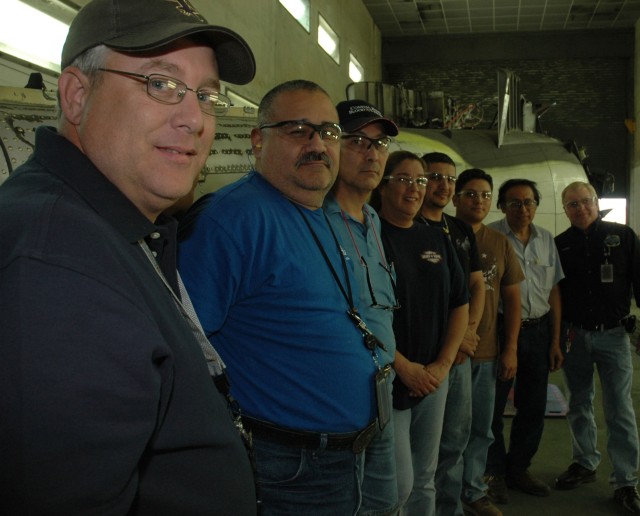CORPUS CHRISTI ARMY DEPOT, Texas. -With delicate precision, Timothy Justice, painter for CCAD, narrows his eyes and begins "painting."
He is using a virtual-reality based paint training simulator called VirtualPaint and he's about to be one of six painters at Corpus Christi Army Depot to receive the very first Chemical Agent Resistant Coating certification from Spray Technique Analysis and Research for Defense.
"[VirtualPaint] is pretty neat," claims Justice. "It gives you an idea of what you need to improve." Slowly panning the screen with his paint gun simulator, Justice finishes coating the large projector screen with an even layer of green which immediately disappears with a click of a button.
Established by the Iowa Waste Reduction Center as a service of the University of Northern Iowa, STAR4D specializes in hands-on painter training for the U.S. Armed Forces. The program offers customized training for military spray technicians with traditional classroom and hands-on teaching methods using state-of-the-art painting equipment.
In their efforts to create a certification course for military spray painters; STAR4D has been working closely with Corpus Christi Army Depot. The CARC certification course establishes a standard method to classify these painters. Six painters received CARC certification on February 5, a certification designed for those who paint or apply chemical resistant coating to products. CCAD is actually the first to certify their painters to the STAR4D training. When the new military National Emission Standards for Hazardous Air Pollutant go into effect, this CARC certification will definitely come in handy.
The STAR4D program is great for any depot or base. They have a program called Train-the-Trainer. An interested installation would send individuals to Iowa where they are trained in the ways of STAR4D. They then return to their depots and train their own painters and develop a certification that fits their needs alongside STAR4D's guidance. Once they receive approval from STAR4D, the depot is granted the ability to certify their painters. This adaptable program works well because each base or depot designs the certification to their individual needs while following uniform STAR4D criteria. According to Rick Klein, STAR4D program manager, the certification program CCAD received not only meets their needs, but the needs of other military paint facilities across the country.
The STAR4D certification has not only helped certify these six painters, but it has also saved the depot money and time. According to James Dussliere and Paul Hughes, shift supervisors in the Fabrication and Coating Division at CCAD, waste has been greatly reduced with the introduction of STAR4D. Before STAR4D training, it was typical to go through three painters, three paint pots, and six gallons of CARC. On top of that, one might expect to find the occasional quality defect or even encounter production delays due to rework and repaint.
Now only a fraction of the paint, painters, and supplies are required to get the same job done. Using less paint and getting a more even coat has also resulted in a lighter aircraft. Helicopters could expect to weigh twenty pounds less than other helicopters when they've been painted by one of CCAD's certified painters. Similarly, quality improves and rework is reduced. There is also a greater occurrence of on-time or early customer delivery, reduced hazardous waste generation, increased advancement opportunities, and, of course, customer satisfaction. "Training is why we have a quality product," Dussliere said. "This program has exceeded all of our expectations."


Social Sharing